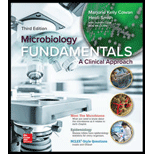
Microbiology Fundamentals: A Clinical Approach
3rd Edition
ISBN: 9781259709227
Author: Marjorie Kelly Cowan Professor, Heidi Smith
Publisher: McGraw-Hill Education
expand_more
expand_more
format_list_bulleted
Question
Chapter 10, Problem 9Q
Summary Introduction
To determine:
The organisms that first possessed beta-lactamases, along with the reason for the same.
Introduction:
Many antibiotics are not effective against bacteria that produce the enzyme beta-lactamase. It is an enzyme produced by bacteria like various strains of Staphylococci. It includes the penicillinase enzyme that damages the
Expert Solution & Answer
Want to see the full answer?
Check out a sample textbook solution
Students have asked these similar questions
please draw in what the steps are given.
Thank you!
please draw in and fill out the empty slots from image below.
thank you!
There is a species of eagle, which lives in a tropical forest in Brazil. The alula pattern of its wings is determined by a single autosomal gene with four alleles that exhibit an unknown hierarchy of dominance. Genetic testing shows that individuals 1-1, 11-4, 11-7, III-1, and III-4 are each homozygous.
How many possible genotypes among checkered eagles in the population?
Chapter 10 Solutions
Microbiology Fundamentals: A Clinical Approach
Ch. 10.1 - State the main goal of antimicrobial treatment.Ch. 10.1 - Identify the sources for the most commonly used...Ch. 10.1 - Describe two methods for testing antimicrobial...Ch. 10.1 - Prob. 4AYPCh. 10.1 - NCLEX PREP 1. An RN is caring for a 26-year-old...Ch. 10.2 - Explain the concept of selective toxicity.Ch. 10.2 - List the five major targets of antimicrobial...Ch. 10.2 - Prob. 7AYPCh. 10.2 - Distinguish between broad-spectrum and...Ch. 10.2 - Prob. 9AYP
Ch. 10.2 - Explain the mode of action of penicillinases and...Ch. 10.2 - Identify two antimicrobials that act by inhibiting...Ch. 10.2 - Prob. 12AYPCh. 10.2 - Identify one example of a fluoroquinolone.Ch. 10.2 - Describe the mode of action of drugs that target...Ch. 10.2 - Prob. 15AYPCh. 10.2 - Prob. 16AYPCh. 10.2 - Explain why antiprotozoal and antihelminthic drugs...Ch. 10.2 - List the three major targets of action of...Ch. 10.2 - Prob. 2NPCh. 10.3 - Discuss two main ways that microbes acquire...Ch. 10.3 - List five cellular or structural mechanisms that...Ch. 10.3 - Prob. 21AYPCh. 10.3 - Prob. 3NPCh. 10.3 - Prob. 1MMCh. 10.4 - Distinguish between drug toxicity and allergic...Ch. 10.4 - Prob. 23AYPCh. 10.4 - Prob. 4NPCh. 10.4 - Prob. 5NPCh. 10 - Microbial resistance to drugs is acquired through...Ch. 10 - Prob. 2QCh. 10 - Prob. 3QCh. 10 - Prob. 4QCh. 10 - Why does the penicillin group of antibiotics have...Ch. 10 - Prob. 6QCh. 10 - Prob. 7QCh. 10 - Conduct research to find out why drugs blocking...Ch. 10 - Prob. 9QCh. 10 - Prob. 10QCh. 10 - You take a sample from a growth-free portion of...Ch. 10 - Prob. 12QCh. 10 - Treating malarial infections is theoretically...Ch. 10 - Can you think of a situation in which it would be...Ch. 10 - Prob. 15QCh. 10 - Prob. 16QCh. 10 - Prob. 17QCh. 10 - Prob. 18QCh. 10 - An antimicrobial drug with a _______ therapeutic...Ch. 10 - Prob. 20QCh. 10 - Prob. 21QCh. 10 - Prob. 1VC
Knowledge Booster
Similar questions
- students in a science class investiged the conditions under which corn seeds would germinate most successfully. BAsed on the results which of these factors appears most important for successful corn seed germination.arrow_forwardI want to write the given physician orders in the kardex formarrow_forwardAmino Acid Coclow TABle 3' Gly Phe Leu (G) (F) (L) 3- Val (V) Arg (R) Ser (S) Ala (A) Lys (K) CAG G Glu Asp (E) (D) Ser (S) CCCAGUCAGUCAGUCAG 0204 C U A G C Asn (N) G 4 A AGU C GU (5) AC C UGA A G5 C CUGACUGACUGACUGAC Thr (T) Met (M) lle £€ (1) U 4 G Tyr Σε (Y) U Cys (C) C A G Trp (W) 3' U C A Leu בוט His Pro (P) ££ (H) Gin (Q) Arg 흐름 (R) (L) Start Stop 8. Transcription and Translation Practice: (Video 10-1 and 10-2) A. Below is the sense strand of a DNA gene. Using the sense strand, create the antisense DNA strand and label the 5' and 3' ends. B. Use the antisense strand that you create in part A as a template to create the mRNA transcript of the gene and label the 5' and 3' ends. C. Translate the mRNA you produced in part B into the polypeptide sequence making sure to follow all the rules of translation. 5'-AGCATGACTAATAGTTGTTGAGCTGTC-3' (sense strand) 4arrow_forward
- What is the structure and function of Eukaryotic cells, including their organelles? How are Eukaryotic cells different than Prokaryotic cells, in terms of evolution which form of the cell might have came first? How do Eukaryotic cells become malignant (cancerous)?arrow_forwardWhat are the roles of DNA and proteins inside of the cell? What are the building blocks or molecular components of the DNA and proteins? How are proteins produced within the cell? What connection is there between DNA, proteins, and the cell cycle? What is the relationship between DNA, proteins, and Cancer?arrow_forwardWhy cells go through various types of cell division and how eukaryotic cells control cell growth through the cell cycle control system?arrow_forward
arrow_back_ios
SEE MORE QUESTIONS
arrow_forward_ios
Recommended textbooks for you
 Biology: The Dynamic Science (MindTap Course List)BiologyISBN:9781305389892Author:Peter J. Russell, Paul E. Hertz, Beverly McMillanPublisher:Cengage Learning
Biology: The Dynamic Science (MindTap Course List)BiologyISBN:9781305389892Author:Peter J. Russell, Paul E. Hertz, Beverly McMillanPublisher:Cengage Learning Concepts of BiologyBiologyISBN:9781938168116Author:Samantha Fowler, Rebecca Roush, James WisePublisher:OpenStax College
Concepts of BiologyBiologyISBN:9781938168116Author:Samantha Fowler, Rebecca Roush, James WisePublisher:OpenStax College


Biology: The Dynamic Science (MindTap Course List)
Biology
ISBN:9781305389892
Author:Peter J. Russell, Paul E. Hertz, Beverly McMillan
Publisher:Cengage Learning


Concepts of Biology
Biology
ISBN:9781938168116
Author:Samantha Fowler, Rebecca Roush, James Wise
Publisher:OpenStax College

